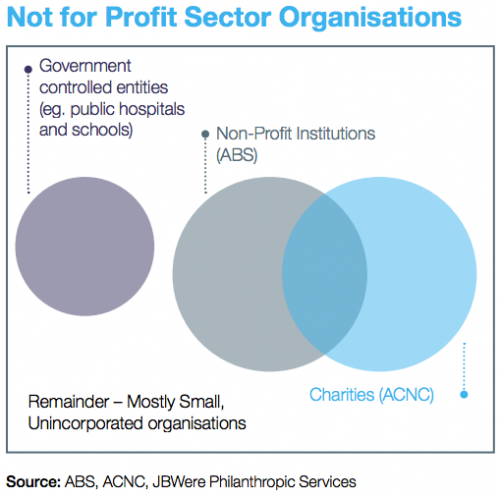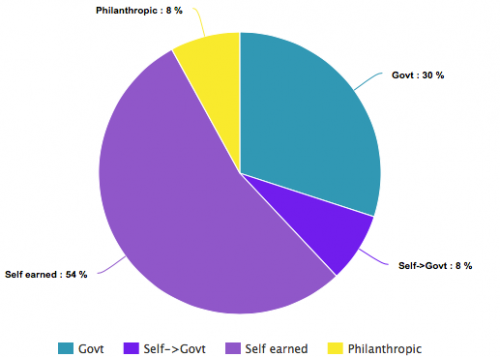Not for profit (r)evolution
The not for profit sector is an integral part of Australian society, and currently it’s undergoing a huge shakeup. Debra Cupitt from One10 shows the opportunities beyond the existing challenges for the continued prosperity of the sector.
The not for profit (NFP) sector has undergone significant changes over the past 20 years, and current data indicates that is this is only the beginning of the huge shakeup in the $200 billion (annual revenue) sector. JBWere has recently published The Cause Report examining the trends in the NFP sector and where opportunities and challenges may emerge.
The NFP sector is an integral part of Australian society. There are a total of around 600,000 organisations, the majority (440,000 estimated by the Productivity Commission) of which are small, unincorporated, volunteer based and generally without legal status (JBWere, 2016). If you’re feeling confused about what a not for profit is, consider the table below.

Of these not for profits, the ACNC (Australian Charities and Not for profits Commission) has recognised 56,894 as charities (that’s one charity for every 422 people), and the Australian Bureau of Statistics (ABS) identifies 57,000 as non profit institutions – some overlap, as shown in the chart.
Over the past 20 years, there have been several significant trends in the sector, including growth and changes in funding mix. There has been an increase in funding from government, from 30% in 1994 to 38% in 2014. This increase filled the gap created by a corresponding 8% decrease (64% to 56%) of self generated funding. The remainder (8%) of NFP income came from philanthropic donations.

1994 – 2014 NFP Income mix – 8% has transitioned from self funded to government funded.
It is important to note that while government funding has been increasing over this extended time period, in the last few years funding cuts have been taking place and look as though they will continue as the government gears itself towards achieving a positive budget.
This change is cause for alarm to some not for profits, especially those which heavily rely on grants to fund their ongoing operations. However, for those willing to innovate and adapt to pursue the prospects opening up to them, there is a wealth of opportunity.
Yet the pursuit of innovation itself will be a challenge within Australia’s current NFP sector. This is due to the high concentration (92%) of assets and income being controlled by the largest 8% of organisations. And there hasn’t been much change in the names of the large organisations dominating the sector – with 10 of the top twenty having remained the same for 20 yrs.
One might argue that the ability of the average NFP to innovate and grow is limited, as they do not have access to risk capital and therefore cannot undertake risky ventures (such as exploring new revenue streams).
With a fall in government funding on the horizon, and an inability to innovate and thus achieve sustainable revenue, the future of many of Australia’s NFPs looks bleak indeed. However, this assessment does not take into consideration two (of many) opportunities for the continued prosperity of the sector.
- Increasing the efficiency of organisations within the sector. This may entail the merging (or, as I prefer, joining forces) of organisations delivering similar services. This would result in reducing administration costs and combining expertise and volunteer bases to provide organisations with increased capacity and resources to explore innovation.
- Building a for-profit arm. This may seem a little wacky and out there to some NFPs, but for others this has long been a tried and true method of supplementing government funding. Purpose driven business ventures will also be able to utilise the current interest and growth in impact investing. Moreover, business has been shown as a fantastic way to deliver many of the solutions to the social and environmental issues that NFPs are trying to address – for example Oxfam sells Fairtrade coffee in its shops. Now that’s the kind of double whammy that will make a difference!
These are not the only solutions, nor may they be the best solution for every organisation. However, the data is clearing indicating that for the NFP sector to remain as effective as possible and to maximise impact, it needs to continue to evolve and faster than in the past. Continued sustainability must involve ongoing (r)evolution of where NFP funding comes from and how it is used.
If your not for profit wants to innovate and explore new revenue streams, get in touch with the One10 team here.
This article first appeared in One10’s blog. It is republished with the permission of the author.
Debra Cupitt is Marketing and Communications Manager at One10. She believes in the power of business to drive positive change in the world and is passionate about using her knowledge and skills to help organisations and businesses operate and grow in a sustainable and socially and environmentally responsible way.











